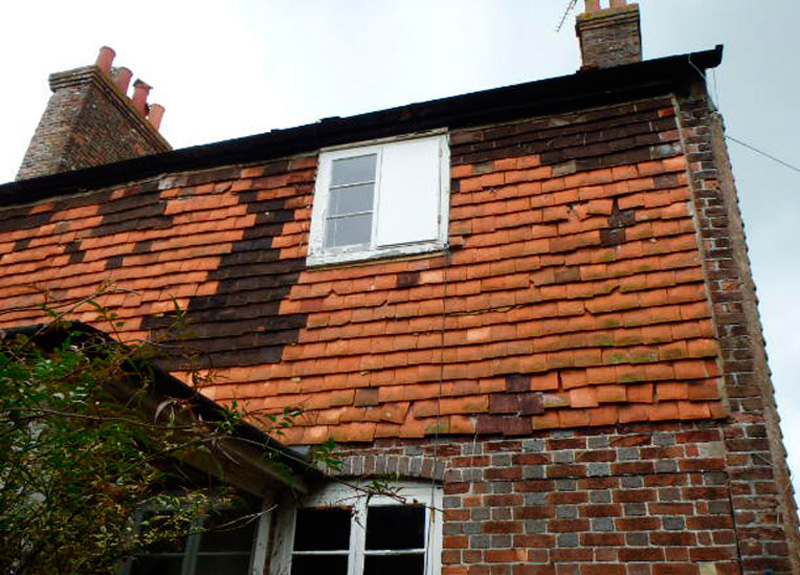Controversy has erupted in Winchelsea about alleged inconsistency in Rother District Council’s conservation policy. A householder in the town has been trying to do his bit to help preserve Winchelsea’s Conservation Area but has nevertheless found himself in hot water with Rother. But another householder, who has been flouting conservation regulations for several years, has been bailed out by Rother. And a third has been allowed by Rother to ignore the Conservation Area. All three stories concern humble clay peg tiles.
In the first case, Rother has objected to the replacement of the tiles on the front slope of a roof on a Grade II listed house. The roof was badly damaged in recent storms. Rother say that the new tiles make the roof look different from those of neighbouring houses in the same terrace, which changes the ‘character and appearance’ of the Winchelsea Conservation Area. On these grounds, they have insisted that the householder remove the new tiles and replace them with second-hand tiles from the rear slope of the roof.
The owner of the property protests that he wrote to Rother in January telling them of the work proposed but received no answer. Rother says it has no record of the letter.
The householder also contends that he has anyway done everything possible to meet the very best conservation standards. Thus, he replaced the old tiles with exact equivalents, which are expensive conservation-grade hand-made Kent peg tiles. He was reluctant to use second-hand tiles, despite their being cheaper, as he was advised that demand for these is encouraging criminals to strip them from listed buildings. He does not believe that using the old tiles from the back roof of his house would have been sensible, as they will also need replacing soon.
And the householder argues that the new tiles will weather very quickly and soon become indistinguishable from older tiles on neighbouring roofs. It has also been noted that, while Rother object to the new tiles because they are lighter than the old ones, the Society for Preservation of Ancient Buildings (SPAB) and the Kent Local Authorities Conservation Officers Group advise that ‘when selecting new tiles for repairs or re-roofing works that tiles which are initially lighter than the existing weathered tiles should be chosen’ as they will weather to give a better match. This last point raises the question of how far Rother would get if they had to go to appeal or ever tried to enforce their objections in court. By the time they got to court, the weathering process would be far advanced.
And does a repair with authentic materials that is temporarily different from its context represent a change in ‘character and appearance’ in the sense intended by planning legislation? If it does, then projects such as the restoration of the Pipewell Gate in Winchelsea will not be able to use new stone but will find ancient stone. Must thatched houses use old thatch? And what about replacing ancient lead-work?
But what makes Rother’s stance more puzzling is the contrast with their policy just one street away, where a Grade II* listed house has been left unoccupied and unmaintained for over a decade. It has walls and a roof of Kent peg tiles. But here, Rother has allowed historic tiles to be replaced with modern concrete tiles of a completely different colour that will never mellow with age. Neighbours have also been complaining to Rother for years about the risk that this deteriorating building poses to their adjoining properties & the risk to themselves as they walk past the building on the shared path leading from their back gardens.
A few years ago, the windows in this house had deteriorated so badly that they were at risk of falling out. After sustained public pressure, Rother finally served a notice under planning law requiring the householder to make repairs. The householder refused to even reply. He was eventually taken to court, found guilty and fined. However, when he continued to refuse to respond, rather than go back to court, Rother paid for the repairs themselves. As a result, the householder got new windows at a cost to the Rother tax-payer of several thousand pounds! Last year, further recent deterioration in the building, including the loss of more tiles, has solicited new repairs by Rother at further cost to the local tax-payer.
In the third case, Rother has recently allowed the extension to a Grade II tile-hung cottage in the town to be boarded with what the householder’s architect has described as “a prefabricated cement fibreboard cladding panel…given a sand blasted finish which…is a play on the Kent peg hanging tiles, using 21st century technology to create a more uniform cladding pattern to contrast the existing house”. In other words, clay tiles were not required at all on this listed building. Rother has also allowed use of “a smooth faced modern brick to add interest and detail…”.
Why has Rother acted so differently in these apparently similar cases? Residents are confused.
Richard Comotto is a member of Winchelsea Heritage



